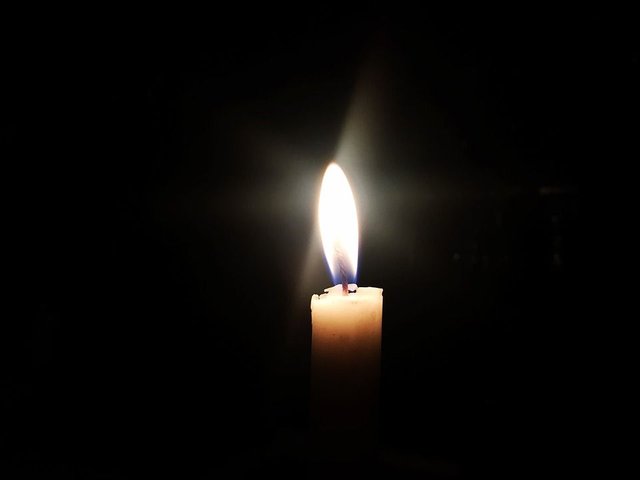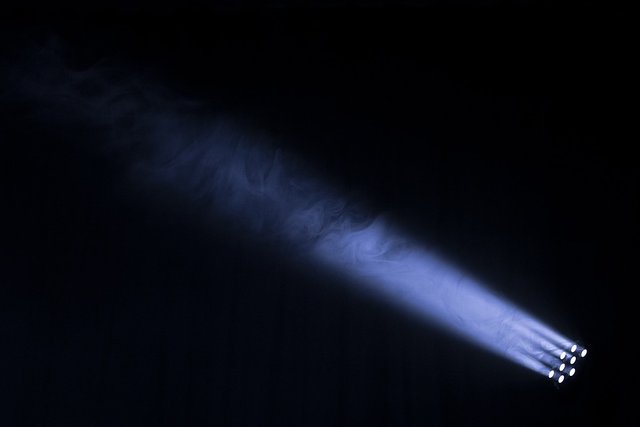The science behind vision is a bit complicated and this happens to arouse my curiosity. So I decided to do some research about it, added to my own personal imagination.
))
image source: pxhere
Without light, seeing will be impossible.
The reason why we see is because light from objects is reflected to our eyes through vacuum space.
))
image credit: pixabay
Then our brain does the interpretation. Hence if there is no light in a room or there is total darkness, seeing becomes impossible because there is no light that will reflect the photons of objects into our eyes.
To understand this better, have you ever pointed a laser pointer into the night sky? If yes, what do you see? Unless you have one of those green lasers, I believe your answer is probably nothing. Same thing is applicable with bright flashlights.
))
photo credit: pixabay
If you point it at the sky, you might see some dust particles floating around, but otherwise it just goes off into nothingness.
The reason is that a light source like the flashlight, laser or the sun only illuminates objects. Brightness only exist because there is something there that can reflect or produce light.
With a flashlight or laser, it is tiny dust particles floating in the all in space, it's planets, moon, steroids and occasional comets.
))
image credit:Max Pixel
Just like a flashlight won't illuminate the night sky, the sun can't illuminate the emptiness of most of our solar solar system. Now, when you are on a planet such as Mars, the sun illuminates everything around you or at least the ground around you because you are surrounded by that object that can reflect the sun's light.
You are able to see a chair in your room because the photons from the chair are being reflected into yours eyes. We see a light turned on because it is emitting photons into our eyes.
However, we can not see photons that are not being absorbed by our eyes. What does that mean?
To answer the question above, I will have to ask another question for a better clarity.
How can you tell if you have turned on a flashlight in a dark room? The answer is easy, a spot of illumination will be made on the wall and all of the dust particles caught in the path of your beam itself being projected from the end of your flashlight to the wall, and you can infer.
Notice that you cannot see the beam of light, but instead you infer that it is there because of the illuminated dust particles.
What if we take dust particles? Then everything will be the same except for the dust particles floating under the laws of Brownian motion everywhere.
Here is where it gets interesting
How do you know the supposed "turned on" flashlight is even on, assuming you are not looking at the bulb but at the path of light it shoots out? The answer is you can't tell if the light is on unless you use a mechanism or an object that will reflect back the photons from the bulb into our eyes. Such as a wall reflecting the photons back at you, or the particles illuminating. Hence you can't know for sure if the light is turned on.
My Theory
This is where my supposed theory comes in, although I am pretty sure its already in existence and known but I have not seen it anywhere before, here it goes anyway:
It states that "We can only see photons if they are being absorbed by our eyes". This same phenomena is what occurs in space, except on a vastly larger scale. We can not see the photons being emitted from the sun unless we look directly into it. This is why space seems dark. It's like turning on a flashlight towards a dark space with no dust or wall to reflect back the projected beam.
We infer that the sun is doing its job when we look at Saturn, Jupiter or even the moon. We see the light reflected into our eyes from the moon, and assume that those rays were originally from the sun but we never see the massive beams of light that comes from the sun hitting the moon and then our eyes, do we? No we don't.
To conclude this, the reason why we see things around us during the day is because the sun projects its light rays on those objects(humans, animal, plants and everything on earth) which is reflected back into our eyes thereby making it possible for us to see those objects. While at night we can't see those objects unless we flash lights on them and they will reflect back those lights into eyes which will make us to see them.
Hence Contact between our eyes and reflected light causes vision.
References:
- Vision and Light-Induced Molecular Changes
- The Role of Light to Sight - The Physics Classroom
- Reflection of light - Science Learning Hub


Being A SteemStem Member
Downvoting a post can decrease pending rewards and make it less visible. Common reasons:
Submit
oh, sight is possible because we are surrounded by objects that reflect light? This context is easier to understand. I had a hard time understanding "eye sight" back in school because rmy teacher made it too complex. I'll read more on reflection. kudos.
Downvoting a post can decrease pending rewards and make it less visible. Common reasons:
Submit
Same with me. When we were studying light reflection and refraction all I could see was equations no vivid explanation of the science behind sight.
Downvoting a post can decrease pending rewards and make it less visible. Common reasons:
Submit
the equations never really helped. No detailed explanation at all. i'm glad we have a chance to re-learn here on steemit though
Downvoting a post can decrease pending rewards and make it less visible. Common reasons:
Submit
Downvoting a post can decrease pending rewards and make it less visible. Common reasons:
Submit
You could have made it more interesting by talking about rods and cones cells. My opinion though :)
Downvoting a post can decrease pending rewards and make it less visible. Common reasons:
Submit
Thank you for the suggestion. I wish this article is a series, I would added it to the second series. Thanks a lot sir.

Downvoting a post can decrease pending rewards and make it less visible. Common reasons:
Submit
Thanx for a detailled blog..
You made good theory..
Yeah we can see only due to light
Downvoting a post can decrease pending rewards and make it less visible. Common reasons:
Submit